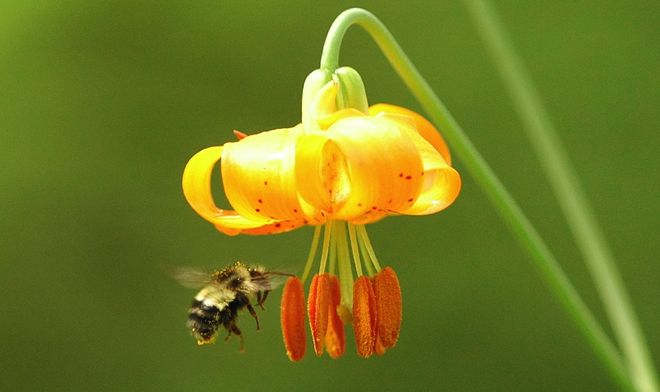Did you know there are roughly 4,000 species of native bees in the United States? From bumblebees, to carpenter bees, to alkali bees, these creatures are critical to our food supply. While managed honey bees often steal the pollinator spotlight, native bees also deserve their fair share of stardom. And what better time to celebrate native bees than the start of fall, when pollinated fruits and vegetables like pumpkins, apples, and squash are welcomed harvests made especially possible by our native bees. So, if you’re like me and can’t imagine Halloween without pumpkins to carve, or Thanksgiving without pumpkin pie, you owe a big thank-you to these bees.
Some fun facts about these fascinating native species:
- Bumblebees are masters of the art of ‘buzzing,’ an amazing and useful movement hardly visible to the human eye. In fact, the pollination of many plants such as tomatoes, potatoes, and cranberries depends on the buzz-vibrations that bumblebees so expertly execute.
- Squash bees, also known as the ‘eastern cucurbit bee’, are dependent entirely on the pollen from cucurbits (squash, pumpkins, melon, zucchini, gourds and cucumbers); their relationship with these crops is mutually beneficial, and squash bees even sync their pollination to the daily rhythms of squash flowers.
- The alkali bee is an extremely desirable pollinator of alfalfa, and some farmers even try to replicate their native nesting habits to encourage this species to thrive around alfalfa fields.
Unfortunately, native bees are facing many of the same hardships as honey bees: the loss of habitat and nutritious forage as a result of industrial agriculture. Vast expansions of monocultures like corn and soy are seriously threatening the health and continued existence of these pollinators. This is only worsened by the exponential use of toxic herbicides, insecticides, and fungicides, which are building up in our environment and poisoning their floral landscapes. The state of pollinator health is an indication of our environment’s health – and right now, bees are the canary in the coal mine, sounding the alarm for bigger problems ahead.
Even though many of the threats to bees will require action from our regulatory agencies, there are steps we can all take to help protect these pollinating species. Perhaps one of the most fruitful (pun intended!) steps is to provide pollinators with habitat and ample forage – plant more seeds and grow more native plants and flowers!
Some excellent fall flower choices that are pollinator-friendly include: asters, goldenrods, sages, sunflowers, and milkweeds. Try to plant a wide variety of colors and shapes to attract a diverse group of pollinating species. Make sure the seeds and plants you buy are not pre-treated with chemicals that are toxic to bees, like neonicotinoids. Buying organic is the best way to avoid bee-toxic seeds and plants.
There are numerous other steps we can all take to ensure bees and other pollinators have healthy habitats across the country:
- Avoid using pesticides
- Provide nesting sites for native bees (wood blocks and dead trees and limbs are some great options. More ideas can be found here.
- Become a beekeeper! The population of urban beekeepers is growing and there are hundreds of beekeeping organizations around the country to help interested and beginning beekeepers
- Support local beekeepers and buy locally-produced honey.
- Contact your Members of Congress and government agencies and let them know you’re concerned about pollinators and want them to take action to protect them.
In so many ways, our farms and gardens play a critical role in the health and vitality of pollinating species. Together, we can work to provide ample forage and healthy habitats for bees and other pollinators across the country.















